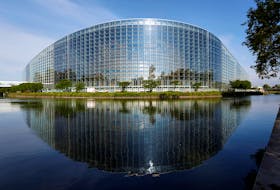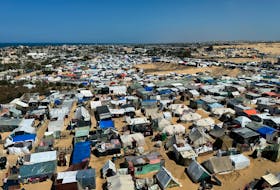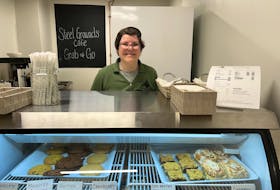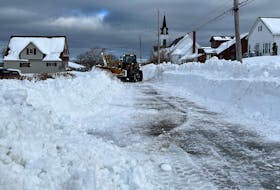CAPE TOWN, SOUTH AFRICA – Originally Day Zero was going to arrive in April. Then it was pushed back to May, to July and to August. Now city officials in Cape Town hope it may not come at all this year due to water conservation efforts carried out in the South African city.
But getting here hasn’t been easy.
Among those having to abide by strict water usage restrictions are some former Yarmouth residents who live in Cape Town, where for months the goal has been to avoid Day Zero – the day that the taps would go dry due to a critically low municipal water supply following a three-year drought.
A few months ago tight water restrictions were put in place, allowing each person to only use 50 litres of water per day.
“While conserving water in such a radical way takes a good deal of preparation, time and effort, it is really quite rewarding to see how creative you can get with water use and re-use and to see how little you can live on quite easily,” said former Yarmouth resident Chelsea Coakley at the time.
Residents were issued guidelines that spelled out how much water they were allowed to use for cooking, brushing teeth, washing hands, laundry, flushing toilets, etc. Even showers were restricted to two minutes. It’s caused people to be resourceful.
“Last year we purchased a large washing basin (it could probably fit about three small children) to stand in while taking showers, and we also have smaller basins collecting grey water in our kitchen and bathroom sink. All of this grey water is then used to fill and flush our toilet tank,” Coakley said. “We use the same system at work, but in addition we have a ‘Wee Wiser’ tool, which you use to indicate to the person after you how many ‘wees’ are in the toilet – the recommendation is flush every four pees.”
There is a system of fresh spring taps in the southern suburbs of Cape Town from which anyone can collect water.
“We use this water for dish washing and other household use so that we can reduce the amount of municipal water needed from the taps,” Coakley said. “We also purchased 500 litres of spring water from a private company, which is stored in our storage room in large containers as backup. We have been using this for drinking water only.”

LIVING IN CAPE TOWN
Coakley has been living in Cape Town since 2015. She had lived there previously in 2005 and again in 2006-2007 for internships and graduate studies.
It’s a part of the world she was immediately captivated by, noting the contrasts and paradoxes that she describes as “magnificent natural beauty and dramatic, diverse landscapes on a backdrop of tremendous social inequality.”
“All of this, while challenging,” she said, “is underpinned by South Africans’ tremendous hope and optimism for the future, and profound resilience.”
Coakley noted in recent months the Day Zero terminology was being used to describe a near and present reality, which was an important communication and preparation strategy for the local, provincial and national governments.
But while for some it was a new reality, for others it was a continuation of daily life, she said.
“Day Zero is a frightening prospect for many middle-to-upper-class residents, but many other people living in poverty live on very little water and routinely collect water elsewhere as part of their daily lives,” she said.
The City of Cape Town says water restriction efforts have paid off in helping to avert a Day Zero by bringing down water consumption. Still, restrictions remain because of an uncertain future.
“With the immediate threat of Day Zero having been averted for now, we still need to stretch our water resources to the maximum to make it through the winter, and through another potentially harsh summer,” the city said in a recent media release. “Our predicament is that we do not know what kind of rainfall to expect. All of us, therefore, need to stick to 50 litres per person per day – rain or shine, and with or without an immediate Day Zero looming.”
COPING IN CAPE TOWN
Jonathan Strug is a former Yarmouthian who has been living in Cape Town for about seven years.
“Cape Town is a very beautiful city. We are on the Atlantic Ocean but very close to where the Atlantic and Indian oceans meet. It is a mountainous area with Table Mountain being right in downtown Cape Town,” he said. “It is a very modern city and depending on which part of the city you are in you might think you were in Europe. On the other hand, Cape Town (and South Africa more generally) has its share of challenges. There is a very high level of inequality and the impact of Apartheid is still very much felt and will take a long time to address.”
He said the water situation has had a dramatic impact on daily life, particularly when people were told not to use more than 50 litres a day.
“To give you an example of what that means, a five-minute shower would average about 40 litres,” he said, noting initially you did not get cut off after using 50 litres (it was primarily public pressure being used for people to reduce their consumption) but later new usage rates were introduced whereby people would have to pay dramatically more if they used over 50 litres.
“This has entailed limiting the number and duration of showers. Washing with a basin when possible. Collecting grey water,” he described when contacted by this newspaper. When showering, run-off was collected in a basin to be used for secondary purposes such as flushing the toilet. People were handwashing clothes as opposed to using a machine so that more grey water could be collected and reused.
Water restrictions were put in place months ago that allowed residents to only use 50 litres of water a day. “To give you an example of what that means, a five-minute shower would average about 40 litres,” says Jonathan Strug.
Strug said a couple of months ago time and volume restrictions, along with posted security, were put in place at South African Breweries where people had free access to collect spring water.
Meanwhile, hundreds of collection points for non-municipal water were set up in the city where people had to line up on a daily basis to collect an allotment of 25 litres.
“You can imagine the level of inconvenience,” Strug said. However, he said, sharing a point made by Coakley, “For many of Cape Town's poorest residents who live in informal settlements (numbering in the 100,000s), it has always been Day Zero for people with no running water who have to collect it at collection points on a daily basis.”
Strug said it was good to see Day Zero pushed back, but each time it was pushed back he hoped it wouldn’t turn into a double-edged sword.
“I hope it encourages people to continue conserving as it is having an impact, as opposed to people feeling that it is less of a reality and going back to non-conserving ways,” he said.
Yarmouth resident Linda Coakley has been in Cape Town visiting her daughter Chelsea. When she arrived in February, the city had averted the April Day Zero date, and the date kept getting pushed back and back.
“When I arrived at the small and tropical Cape Town airport, I observed a lively hanging sculpture of assorted empty water bottles hung among colourful big beads, all strung together and moving in light breezes. A first visual recognition of the theme of the water woes,” she recalled. “Literally everywhere are clever, artful signs reminding, imploring, folks to conserve.”
Her daughter, meanwhile, says there is concern about whether they are in a weather pattern that is likely to cause serious droughts and a water crisis year after year.
“There are many solutions that other dry-climate countries and cultures have been using in the Middle East and elsewhere on the African continent, so it does seem manageable, but it will require significant adaptation in technology and people’s behaviour,” Chelsea Coakley said.
Yet even with the recent water crisis that unfolded, she never considered leaving Cape Town.
“I feel very fortunate to live in the coastal city of Cape Town, waking up to a humbling 1,000-metre natural wonder, Table Mountain, each morning,” she said of the cosmopolitan city that contains a fusion of unique African, European and South and East Asian cultures. “Cape Town is also the home of many refugees from various parts of the continent, as well as permanent residents from many African and European nations, as well as many a Canadian and American.”
Strug is also happy with his choice of location.
“I had done my initial two post-secondary degrees at Canadian universities and wanted to do my masters abroad,” he said. “Cape Town was a good program and South Africa seemed like an interesting place to study. I obviously like it here as I have stayed.”









